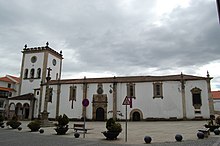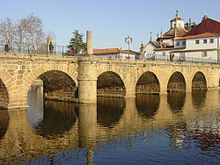|
Alto Trás-os-Montes
Alto Trás-os-Montes (Portuguese pronunciation: [ˈaltu ˌtɾaz uʒ ˈmõtɨʃ]), or Nordeste Transmontano, is a former NUTS-level 3 subregion of the Norte Region of Portugal. It was abolished at the January 2015 NUTS 3 revision.[2] Its 15 municipalities occupied an area of 8,168 km2 (3,154 sq mi) in the north-east of continental Portugal with an estimated 2008 population of 214,460 inhabitants; thus it constituted approximately 40% of the area, but only 6.1% of the population, of the Norte Region. GeographyThe Trás-os-Montes area refers to a contiguous territory that has similar social and cultural identities, but diverges on the potential economic abilities, while constituting a territorial unit with scale and critical mass to act in concert politically.[3] In addition to its land border with Spain (in the north and north-northeast), it is also juxtapositioned with the subregions of the Douro (to the south), Tâmega Subregion (in the southwest), Ave (in the southwest) and Cávado (in the west). The NUTS III region of Alto Trás-os-Montes includes the following municipalities:
The inhabitants are not homogeneously distributed within the region: with most of the population concentrated in the principal urban agglomerations, the region has experienced a continuous process of rural-to-urban population migration to centres within or outside the region. Yet, simultaneously, the medium-to-small centres have taken on a catalytic role in urbanization and economic development. The structure of the Trás-os-Montes hierarchy is highlighted by the largest of these "medium"-sized cities (Bragança, Mirandela and Chaves), corresponding to the principal urban poles, and articulated by a complementary urban network, constituted by the seats of the municipalities of Alfândega da Fé, Boticas, Macedo de Cavaleiros, Miranda do Douro, Mogadouro, Montalegre, Ribeira de Pena, Valpaços, Vila Flor, Vila Pouca de Aguiar, Vimioso and Vinhais. The proximity of Trás-os-Montes with Spain has allowed a cross-cultural and cross-social partnership, that has helped to develop both social and economic projects. Economy  Institutionally, the municipalities of the Trás-os-Montes are aggregated into three associations that plan and promote regional development tasks within the region: Associação de Municípios da Terra Fria do Nordeste Transmontano (which include Bragança, Miranda do Douro, Mogadouro, Vimioso and Vinhais), the Associação de Municípios da Terra Quente Transmontana (with Alfândega da Fé, Macedo de Cavaleiros, Mirandela and Vila Flor) and Associação de Municípios do Alto Tâmega (Boticas, Chaves, Montalegre, Ribeira de Pena, Valpaços and Vila Pouca de Aguiar).[4] The municipality of Mogadouro falls within the Associação de Municípios do Douro Superior. The AMTF-NT assumes the largest part of regional development funding and organizational motivation.[5] The agro-forestry activities in the region are transitioning to socially or economically viable commerce sectors, with the emigration of more residents into the urban areas. Agriculture, with its base in the production of olive oil, the raising of cattle, and cultivation of fruit orchards, remains the primary source of income in this region. References
  |
||||||||||||||||||||||||||||||||||||||||||

